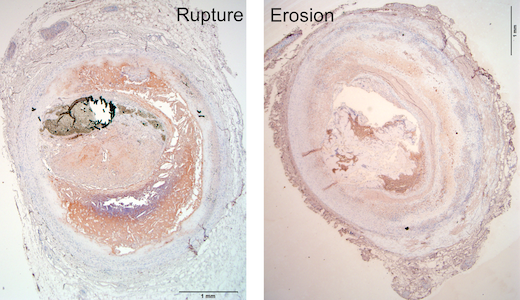Cardiologist Bob Taylor and colleagues have a new paper in PLOS One this week, looking at the biomechanical forces behind plaque erosion.
Plaque erosion is a mechanism for blood clots formation in coronary arteries that is not as well-understood as its more explosive counterpart, plaque rupture. Plaque erosion disproportionally affects women more than men and is thought to account for most heart attacks in younger women (women younger than 50).
“We believe that this work has implications for our better understanding of the underlying biology of coronary artery disease in women,” Taylor says. The first author of the paper is biomedical engineering graduate student Ian Campbell, who now has his PhD. The team collaborated with cardiovascular pathologist Renu Virmani in Maryland.
Cardiologists have well-developed ideas for how plaque rupture works*; see the concept of vulnerable plaque. Cholesterol and inflammatory cells build up in the coronary arteries over several years. At one point in a particular artery, the plaque has a core of dying inflammatory cells, covered by a fibrous cap. If the cap is thin (the patterns of blood flows near the cap influence this), there is a risk that the cap will break and the contents of the core will spill out, triggering a blood clot nearby.
Plaque erosion is more mysterious and can occur more gradually, the researchers have found. Campbell and colleagues examined samples of coronary plaque from humans, calculating physical forces within the plaques as well as looking for signs of inflammation.
Dark staining for inflammation-related proteins can be seen in samples that represent plaque rupture, but not in those representing plaque erosion (the dark staining comes from antibodies applied to the samples; an example at left). Note: in this study, the plaque samples were not analyzed with respect to patient gender.
With plaque erosion, there is no connection between mechanical strain and inflammation in the same way as with plaque rupture, the researchers found. The results do suggest that inflammation plays less of a role in plaque erosion, with implications for some current clinical trials investigating whether anti-inflammatory strategies can prevent cardiovascular disease events (CIRT and CANTOS).
Taylor and his colleagues also have a related publication analyzing plaque erosion and fluid mechanics in a small number of heart disease patients.

